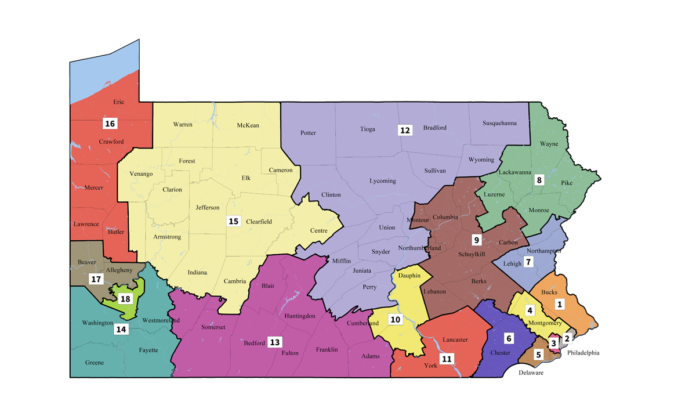On Feb. 19, the Pennsylvania Supreme Court released a new congressional map that will take effect by the May 15 primary elections.
The former map from 2011 has been criticized over the issue of gerrymandering. Under the former map, 13 districts leaned Republican while the remaining 5 leaned Democratic, creating a dilution of some individual’s votes based on political party. With the new map, the district lines are drawn to better represent the close to 50-50 split of party affiliation in Pennsylvania.
This relatively even split between Republican and Democratic votes can be seen in the statewide voting totals. For example, in the 2016 presidential election according to the PA Department of State, 2,970,733 voters in Pennsylvania voted for Donald Trump while 2,926,441 voted for Hillary Clinton, a difference of 0.73 percent. In the same election, Patrick Toomey, R, gained 1.43 percent more votes than Katie McGinty, D, for United States Senator while Joshua Shapiro, D, gained 2.78 percent more votes than John Rafferty, Jr. for Attorney General.
“Whenever you see statewide, voters in PA are pretty evenly split, that you see the 50-50 split and think, OK, if we have 18 districts, you would assume that nine would be Democratic and nine would be Republican, that would be the automatic assumption. But then whenever you see that it’s so lopsided in favor of the Republicans, then you start wondering what’s happening here,” Dr. Heather Rice, SRU political science professor who teaches State and Local Government, said.
According to Rice, the Supreme Court of Pennsylvania previously determined that congressional lines have to be contiguous, race can’t be the only factor when drawing the lines and all districts need to have a roughly equal population. Now, political parties are being considered in districting, adding to these preexisting requirements.
“Beyond that, the court has said we’re not going to deal with this question of partisan gerrymandering, this question of diluting the power of party voters. Here, the PA State Court is saying we are going to force you to consider this question, whether it’s OK if an individual’s vote is diluted on the basis of their party,” Rice said.
While this change does not change the process of voting, how a vote is counted will change beginning in the upcoming primary elections. Under the former congressional map, all of Butler County was within the 3rd congressional district. Now, the county will be split between the 15th and 16th districts.
The western side of the county, including Slippery Rock, will be in the 16th congressional district along with Erie, Crawford, Mercer and Lawrence counties. The remainder of Butler County will be in the 15th district along with 13 other Armstrong, Clarion, Venango, Warren, Forest, Jefferson, Indiana, Cambria, Clearfield, Elk, McKean, Cameron and Centre counties.








